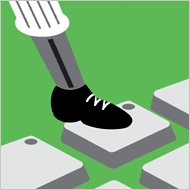It Gets Late Early Out There
In Major League Baseball, experience can take you only so far. ...
If in seven years you went from being a bouncing baby boy to Old Man River, you would most likely look around to try to figure out which mirror you had broken. But in the world of Major League Baseball, that is exactly what happens to you — if you’re lucky.
You enter the big leagues (usually) as a young, vibrant, wide-eyed rookie, inspired and inspiring and still able to talk about your career with the excitement of a 5-year-old. Then, at the speed of light, you’re a seasoned veteran, with loads of “experience” by the ripe old age of 34, and it takes two whirlpool massages just to get ready for batting practice.
In 2005, with one week remaining at the New York Yankees’ spring training camp, Manager Joe Torre and General Manager Brian Cashman called me into the visiting team locker room office after a game against my former employer, the Philadelphia Phillies. I knew I wasn’t standing on solid ground, since it hadn’t been the best spring training of my career. But it wasn’t my first rodeo, either.
I had been brought in by the Yankees as a hired gun to support an oft-injured outfield and to provide the sort of depth where, should one of their star outfielders need a day off, the team wouldn’t be losing that much in leadership. But after all was said and done, here I was in a 6-by-8 makeshift conference room about to get my pink slip.
I suppose I expected something dramatic and profound as an explanation for my getting fired. But Torre just told me, “We are going to have to let you go,” and all I could really muster was a “thanks for the opportunity” — even though I thought they were making a mistake.
Apparently, I didn’t knock their socks off as I had hoped. In the week preceding this meeting, I hadn’t gotten a hit in two games. So, after 15 years of service in baseball and 6,000-plus at bats in more than 1,700 professional games . . . it came down to two performances, which could have meant nothing or everything, depending on the eye of the beholder.
In theory, I had come to the Yankees ready to play ball “from Day One.” The idea that my history didn’t give me the benefit of the doubt was disconcerting. Because there was this younger kid, who played a little better than I did that spring and who would certainly be less expensive. I’d had a bad week, and he’d had a good week, and that made all the difference.
I understood that I was now entrenched on the other side of the bell curve. I was sliding downward into the “long in the tooth” spiked pit. My competition’s relatively minimal major league experience had become more valuable, in a way, than my library of experience. Somehow I had missed the transition point in my career where my value to a team had intersected with the value of a new kid on the block.
There was a time in Philadelphia when, as a young player, I had replaced the veteran Lenny Dykstra as the new center fielder in town, much to the dismay of the Philly faithful. But I felt I had plenty to offer. Maybe I wasn’t as wise as Lenny in terms of game experience, but I thought I made up for it with enthusiasm, newness and energy.
So I understand the cycle.
Young players don’t want to feel dismissed just because they haven’t been around the block any more than veterans want to have their years of experience discarded. And after all, there are different types of contributions, to be made by young and old, that can get a team to the same place. It just depends on what you are looking for and how you want it done.
However, there is an exception to the typical “experience pecking order”: when a player comes along who is so fantastic that he makes time stop. Those timeless performers who transcend any kind of curve you can throw up on that graph. I would venture to say that Alex Rodriguez was one of those players who, within a short period, already seemed as if he had been playing the game for as long as the most experienced players.
And I recall seeing an electric young pitcher, Kerry Wood, when he was the ripe old age of 19. He had yet to set foot in a major league stadium when we watched him pitch in an instructional league game in Arizona. Nevertheless, that didn’t stop me and everyone else from realizing that he was a man among boys. Years later, he would set the record for most strikeouts in a game. He just had something that made his blank sheet of experience rise to the top of a pile of bullet-point-riddled résumés.
These inspirational anomalies make us understand that experience and time are not one and the same. You could have sat in major league locker rooms for decades and still not have the impact of a one-person movement. And when that kind of universal and era-free player comes knocking, we have to answer the door and let him in.
I wore the number 6 for many years as a Philadelphia Phillie. Not that I expected my number to be retired when I stopped playing, but in a flash, Ryan Howard took number 6 and wore it the next year. He went on to be the most valuable player of the National League and the rookie of the year to boot. A true phenomenon.
So I came to understand — quickly — that Ryan will do my old number justice. After you give it your best shot and do all you can, it is easier to step aside when a force of nature is replacing you. In fact, in some cases, for the good of the game it would be selfish if you didn’t.
Doug Glanville, who played nine years in the major leagues for the Cubs, Phillies and Rangers, is writing this guest column during the 2008 baseball season. Glanville served on the executive subcommittee of the Major League Baseball Players Association and is currently a consultant with Baseball Factory, a high-school player development program. He graduated from the University of Pennsylvania in 1992 with a degree in systems science and engineering.
New York Times 04/25/2008
http://topics.nytimes.com/topics/reference/timestopics/people/g/doug_gla...






